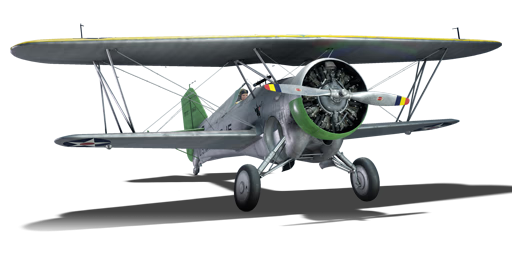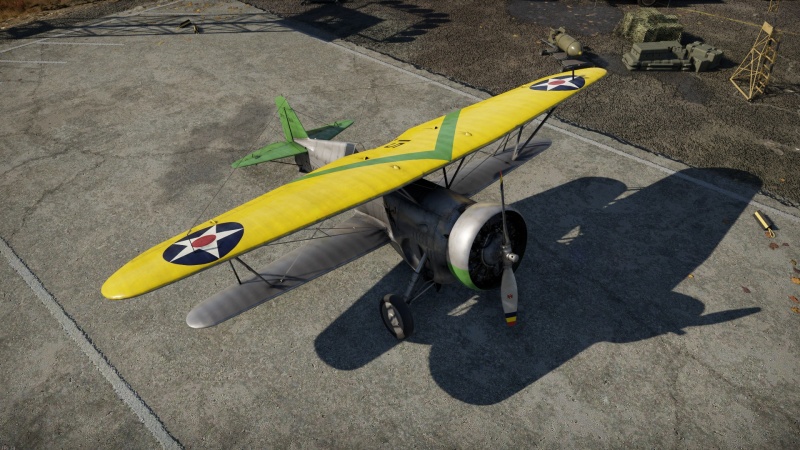Difference between revisions of "BF2C-1"
(pros, cons and description) (Tag: Visual edit) |
(History) (Tag: Visual edit) |
||
| Line 117: | Line 117: | ||
== History == | == History == | ||
| − | + | The '''Curtiss BF2C Goshawk''' ('''Model 67''') was a United States 1930s naval biplane aircraft that saw limited success and was part of a long line of Hawk Series airplanes made by the Curtiss Aeroplane and Motor Company for the American military, and for export as the '''Model 68 Hawk III'''. | |
| − | '' | + | |
| + | The United States Navy and Curtiss felt that the F11C-2 possessed development potential, and the Navy decided to procure a variant with retractable landing gear. This variant, which still had the F11C-2's classic "Hawk" wood wing with its flat-bottomed Clark Y airfoil, was designated '''XF11C-3''' by the Navy and '''Model 67''' by Curtiss. The main gear retraction system was inspired by the Grover Loening-designed system on the Grumman XFF-1 prototype, and was manually operated. | ||
| + | |||
| + | The XF11C-3 was first delivered to the USN in May 1933, with a Wright R-1820-80 radial engine rated at 700 hp (520 kW). Trials revealed a 17 mph (27 km/h) increase in speed over the F11C-2, but the extra weight caused a decrease in maneuverability. The Navy felt the handling degradation was more than offset by the increase in speed, however. During testing the XF11C-3 had its wood-framed wing replaced by the metal-structured, biconvex, NACA 2212 airfoil wing, and soon after was redesignated '''XBF2C-1''' (Model 67A) in keeping with the new Bomber-Fighter category. | ||
| + | |||
| + | Twenty-seven '''BF2C-1''' were ordered by the U.S. Navy, with a raised rear turtledeck, a semi-enclosed cockpit, and a metal-framed lower wing. It was armed with two .30 calibre Browning machine guns and three hardpoints for 500 lb (230 kg) of external stores. Delivered in October 1934, they were assigned to VB-5B on the aircraft carrier USS ''Ranger'', but served only a few months before difficulties with the landing gear led to their withdrawal. In spite of its short service run, many of the innovations developed for the '''Goshawk''' line found wide use in Navy aircraft in the years that followed. They were the last Curtiss fighter accepted for service with the U.S. Navy. | ||
== Media == | == Media == | ||
Revision as of 21:34, 15 June 2023
Contents
Description
The BF2C-1 Goshawk is a rank I American fighter with a battle rating of 1.0 (AB/RB/SB). It was introduced in Update "La Royale".
A carrier-based biplane fighter available to new players as a reserve. It has the peculiarity of being the only reserve biplane (and reserve plane overall) in the game with a retractable landing gear, giving it an advantage when it comes to aerodynamics.
Furthermore, the Goshawk is also capable of providing close air support, making it a nice pick for mixed battles.
General info
Flight performance
Describe how the aircraft behaves in the air. Speed, manoeuvrability, acceleration and allowable loads - these are the most important characteristics of the vehicle.
| Characteristics | Max speed (km/h at _,___ m) |
Max altitude (metres) |
Turn time (seconds) |
Rate of climb (metres/second) |
Take-off run (metres) | |||
|---|---|---|---|---|---|---|---|---|
| AB | RB | AB | RB | AB | RB | |||
| Stock | ___ | ___ | 10700 | __._ | __._ | __._ | __._ | ___ |
| Upgraded | ___ | ___ | __._ | __._ | __._ | __._ | ||
Details
| Features | ||||
|---|---|---|---|---|
| Combat flaps | Take-off flaps | Landing flaps | Air brakes | Arrestor gear |
| _ | _ | _ | _ | _ |
| Limits | ||||||
|---|---|---|---|---|---|---|
| Wings (km/h) | Gear (km/h) | Flaps (km/h) | Max Static G | |||
| Combat | Take-off | Landing | + | - | ||
| 0 | 280 | ___ | ___ | ___ | ~__ | ~__ |
| Optimal velocities (km/h) | |||
|---|---|---|---|
| Ailerons | Rudder | Elevators | Radiator |
| < ___ | < ___ | < ___ | > ___ |
Survivability and armour
Examine the survivability of the aircraft. Note how vulnerable the structure is and how secure the pilot is, whether the fuel tanks are armoured, etc. Describe the armour, if there is any, and also mention the vulnerability of other critical aircraft systems.
Modifications and economy
Armaments
Offensive armament
The BF2C-1 is armed with:
- 2 x 7.62 mm Browning machine guns, nose-mounted (600 rpg = 1,200 total)
Suspended armament
Describe the aircraft's suspended armament: additional cannons under the wings, bombs, rockets and torpedoes. This section is especially important for bombers and attackers. If there is no suspended weaponry remove this subsection.
Usage in battles
Describe the tactics of playing in the aircraft, the features of using aircraft in a team and advice on tactics. Refrain from creating a "guide" - do not impose a single point of view, but instead, give the reader food for thought. Examine the most dangerous enemies and give recommendations on fighting them. If necessary, note the specifics of the game in different modes (AB, RB, SB).
Pros and cons
Pros:
- Capable of taking off and landing on aircraft carriers;
- Has a retractable landing gear, unlike other reserve aircraft;
- Being a biplane, it's easy to fly;
- Features suspended armament, which comes in handy in mixed battles.
Cons:
- Weak offensive armament;
- Suspended armament requires precise hits in order to damage medium and heavily armoured targets;
- Being a biplane, it's slow.
History
The Curtiss BF2C Goshawk (Model 67) was a United States 1930s naval biplane aircraft that saw limited success and was part of a long line of Hawk Series airplanes made by the Curtiss Aeroplane and Motor Company for the American military, and for export as the Model 68 Hawk III.
The United States Navy and Curtiss felt that the F11C-2 possessed development potential, and the Navy decided to procure a variant with retractable landing gear. This variant, which still had the F11C-2's classic "Hawk" wood wing with its flat-bottomed Clark Y airfoil, was designated XF11C-3 by the Navy and Model 67 by Curtiss. The main gear retraction system was inspired by the Grover Loening-designed system on the Grumman XFF-1 prototype, and was manually operated.
The XF11C-3 was first delivered to the USN in May 1933, with a Wright R-1820-80 radial engine rated at 700 hp (520 kW). Trials revealed a 17 mph (27 km/h) increase in speed over the F11C-2, but the extra weight caused a decrease in maneuverability. The Navy felt the handling degradation was more than offset by the increase in speed, however. During testing the XF11C-3 had its wood-framed wing replaced by the metal-structured, biconvex, NACA 2212 airfoil wing, and soon after was redesignated XBF2C-1 (Model 67A) in keeping with the new Bomber-Fighter category.
Twenty-seven BF2C-1 were ordered by the U.S. Navy, with a raised rear turtledeck, a semi-enclosed cockpit, and a metal-framed lower wing. It was armed with two .30 calibre Browning machine guns and three hardpoints for 500 lb (230 kg) of external stores. Delivered in October 1934, they were assigned to VB-5B on the aircraft carrier USS Ranger, but served only a few months before difficulties with the landing gear led to their withdrawal. In spite of its short service run, many of the innovations developed for the Goshawk line found wide use in Navy aircraft in the years that followed. They were the last Curtiss fighter accepted for service with the U.S. Navy.
Media
Excellent additions to the article would be video guides, screenshots from the game, and photos.
See also
Links to the articles on the War Thunder Wiki that you think will be useful for the reader, for example:
- reference to the series of the aircraft;
- links to approximate analogues of other nations and research trees.
External links
Paste links to sources and external resources, such as:
- topic on the official game forum;
- other literature.
| USA fighters | |
|---|---|
| P-26 Peashooter | P-26A-33 · P-26A-34 · P-26A-34 M2 · P-26B-35 |
| P-36 Hawk | P-36A · Rasmussen's P-36A · P-36C · ○P-36C · P-36G |
| P-39 Airacobra | P-400 · P-39N-0 · P-39Q-5 |
| P-40 | P-40C · P-40E-1 · P-40E-1 TD · P-40F-10 |
| P-43 Lancer | P-43A-1 |
| P-47 Thunderbolt | P-47D-22-RE · P-47D-25 · P-47D-28 · P-47M-1-RE · ⋠P-47M-1-RE · P-47N-15 |
| P-51 Mustang | P-51 · P-51A (Thunder League) · P-51C-10 · P-51D-5 · P-51D-10 · P-51D-20-NA · P-51D-30 · P-51H-5-NA |
| P-63 Kingcobra | P-63A-5 · P-63A-10 · P-63C-5 · ␠Kingcobra |
| Prototypes | XP-55 |
| F2A Buffalo | F2A-1 · Thach's F2A-1 · F2A-3 |
| BF2C | BF2C-1 |
| F3F | F3F-2 · Galer's F3F-2 |
| F4F Wildcat | F4F-3 · F4F-4 |
| F4U Corsair | F4U-1A · F4U-1A (USMC) · F4U-1D · F4U-1C · F4U-4 · F4U-4B · F4U-4B VMF-214 · F2G-1 |
| F6F Hellcat | F6F-5 · F6F-5N |
| F8F Bearcat | F8F-1 · F8F-1B |
| Other countries | ▃Ki-43-II · ▃Ki-61-Ib · ▃A6M2 · ▃Bf 109 F-4 · ▃Fw 190 A-8 · ▃Spitfire LF Mk IXc |





